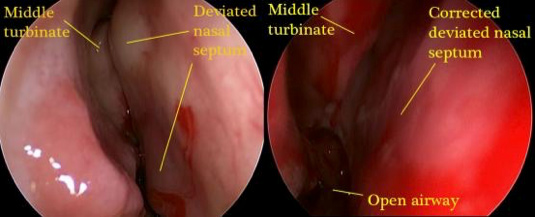The nasal septum is the thin wall that separates the right and left sides of the nose. Not only does it divide the nasal airflow, it also provides part of the support for the external nasal structure. The septum is made up of thin bone and cartilage covered on either side with a blanket of mucosal lining. A deviated septum is the name given when the nasal septum is farther to the right or the left instead of being directly in the middle. This is an extremely common condition and occurs during development and growth or after trauma to the nose.
DIAGNOSIS:
The diagnosis of a deviated septum is based upon a thorough history and physical exam, which often includes a diagnostic nasal endoscopy. A deviated septum can be completely asymptomatic, but often it will narrow one or both nasal cavities and contribute to the sensation of nasal blockage/congestion. The septum can also be deviated in different areas to both sides causing nasal congestion on both sides of the nose. A nasal cavity narrowed by a deviated septum is much more susceptible to blockage due to build of mucus. Furthermore, a deviated septum can block the outflow of the contents of the paranasal sinuses, predisposing patients to sinusitis.
TREATMENT:
Symptoms of a deviated septum may be treated with topical nasal sprays including nasal steroid sprays to decrease the size of the surrounding tissue and make more space to accommodate airflow. While not truly changing the septal deviation, these treatments can improve the surrounding mucosa to give the most airflow possible.
However, if this is not effective, your physician may recommend a surgical procedure to straighten the septum called a septoplasty.


